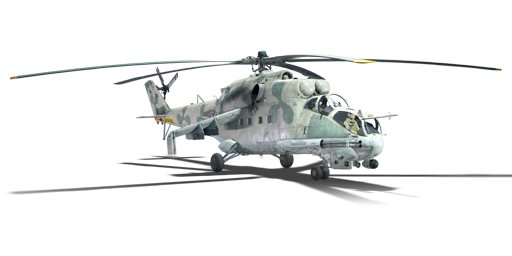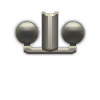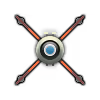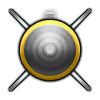



In 1981, a dedicated anti-tank variant of the Mi-24V was devised, replacing the gunner-controlled, nose-mounted 12.7 mm turret with a pilot-controlled fixed Gsh-30-2K twin-barrel 30 mm cannon from an Su-25 for anti-tank duties. The resulting variant, named the Mi-24P, would quickly enter service, and would also be exported alongside the Mi-24V to many countries.
The Mi-24P (NATO reporting name: Hind-F) was introduced in Update 1.81 "The Valkyries". The Mi-24P is very similar to the previous Mi-24V, having the same airframe, technology, and weapons. The only difference is the gun armament: the chin-mounted 12.7 mm Gatling gun has been replaced with a fixed GSh-30-2K cannon mounted on the right side of the nose for anti-armour duties. This is the same type of cannon mounted on the Su-25 attack jet, another Soviet "flying tank". Although it is difficult to aim, a quick burst from the cannon can shred lightly armoured vehicles. Thus, the Mi-24P is a sidegrade to the previous Mi-24V, being more focused on anti-armour duties than anti-infantry.
| Belt | Belt filling | Armor penetration (mm) at a distance: | |||||
|---|---|---|---|---|---|---|---|
| 10 m | 100 m | 500 m | 1000 m | 1500 m | 2000 m | ||
| HEFI-T/APHE | 47 | 46 | 39 | 32 | 26 | 21 | |
| AP-T/HEF-I/APHE/HEF-I | 62 | 60 | 51 | 42 | 35 | 29 | |
| AP-T/APHE/APHE | 62 | 60 | 51 | 42 | 35 | 29 | |
| APHE/HEF-I/HEF-I/HEFI-T | 47 | 46 | 39 | 32 | 26 | 21 | |
| APHE/HEF-I/HEF-I | 47 | 46 | 39 | 32 | 26 | 21 | |
| Name | Weight | Slot | ||||||
|---|---|---|---|---|---|---|---|---|
| 2 × | 93 kg |  |  |  |  | |||
| 43.5 kg |  |  | ||||||
| 2 × | 87 kg |  |  | |||||
| 44 kg |  |  | ||||||
| 2 × | 88 kg |  |  | |||||
| 20 × | 326 kg |  |  |  |  | |||
| 235 kg |  |  |  |  | ||||
| 250 kg |  |  |  |  | ||||
| 94.3 kg |  |  |  |  | ||||
| 2 × | 352.2 kg |  |  |  |  | |||
| 478 kg |  |  | ||||||












Flight performance |
|---|
Survivability |
|---|
Weaponry | ||||
|---|---|---|---|---|